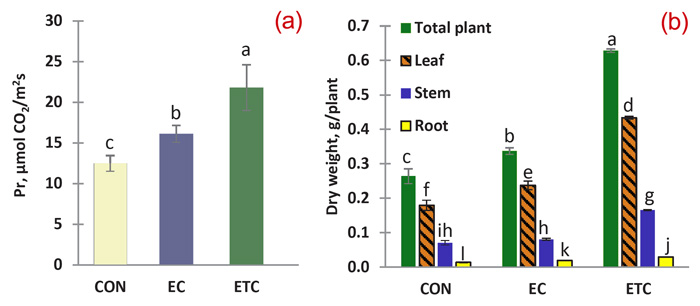| Tweet | Follow @co2science |
Paper Reviewed
Juozapaitiene, G., Diksaityte, A., Sujetoviene, G., Aleinikoviene, J. and Juknys, R. 2019. Aboveground and below-ground carbon allocation of summer rape under elevated CO2 and air temperature. Agricultural and Food Science 28: 1-8.
In the global warming debate climate alarmists typically present a myopic view of the impacts of rising concentrations of atmospheric CO2 on the biosphere. Almost without exception, the only effects thee foresee are negative ones.
Such is the case when it comes to the impacts of elevated CO2 on plant growth and development. Notwithstanding an overwhelming and undeniable collection of scientific literature conclusively demonstrating positive growth responses to higher levels of CO2, climate alarmists refuse to accept such findings, claiming instead that they will be negated by concomitant stresses caused by global warming, such as droughts or heatwaves.
Fortunately, the scientific literature has addressed these concerns, providing ample evidence that they are vastly overrated. The latest study to confirm as much comes from the work of Juozapaitiene et al. (2019), who demonstrate that future CO2-induced growth benefits will actually be augmented (as opposed to being cancelled out) if temperatures rise in tandem with CO2.
Working with summer rape (Brassica napus cv. Fenja), the five Lithuanian researchers who authored this study exposed seedlings of this key European crop to two temperature and two CO2 treatments for a period of four weeks in controlled-environment chambers at Vytautas Magnus University, Kaunas, Lithuania. The experimental treatment conditions utilized in the study included (1) ambient temperature (day/night regime of 25/18 °C) and ambient CO2 (400 ppm), (2) ambient temperature and elevated CO2 (800 ppm), and (3) elevated temperature (day/night regime of 25/18 °C) and elevated CO2. At the end of the 4 week treatment period the authors conducted a series of measurements on various plant photosynthetic and growth-related parameters.
The results of those measurements revealed a CO2-induced stimulation of plant photosynthesis in the ambient temperature and elevated CO2 (EC) treatment that was 29% higher than that observed in the ambient temperature and ambient CO2 (CON) treatment. What is more, rather than declining in the elevated temperature and elevated CO2 (ETC) treatment, the photosynthetic rate increased even higher to a value that was 75% greater than that measured in the CON environment (see Figure 1a). Similar findings were observed with plant biomass; total plant dry weight of Brassica napus was enhanced by 1.3 times in the EC treatment and by a much larger 2.4 times in the ETC treatment.
Commenting on these positive growth interactions between elevated CO2 and temperature, Juozapaitiene et al. write that they are "explained by [an increase in] optimal temperature for plant growth (Long and Drake, 1991; McMurtrie and Wang, 1993) and net photosynthesis (Bernacchi et al., 2006; Alonso et al., 2009) under elevated CO2." Citing the work of Long and Drake (1991), they continue explaining this beneficial outcome by noting that "the optimal temperature for many C3 plants may increase by approximately 5 °C, as CO2 increases by 300 ppm, as was the case in the current experiment."
Consequently, as future atmospheric CO2 concentrations rise, so will the optimum temperature (Topt) of plant photosynthesis in summer rape. And because the CO2-induced rise in Topt is generally much greater than predictions of future temperature rise, summer rape growth and yield will be enhanced, not compromised.

Figure 1. Photosynthesis (a) and dry weight (b) responses of Brassica napus following four weeks of treatment. CON = ambient temperature and ambient CO2 conditions, EC = ambient temperature and elevated (+400 ppm) CO2 conditions, ETC = elevated temperature (+4°C) and elevated (+400 ppm) CO2 conditions. Source: adapted from Juozapaitiene et al. (2019).
References
Alonso, A., Perez, P. and Martinez-Carrasco, R. 2009. Growth in elevated CO2 enhances temperature response of photosynthesis in wheat. Physiologia Plantarum 135: 109-120.
Bernacchi, C.J., Leakey, A.D.B., Heady, L.E., Morgan, P.B., Dohleman, F.G., McGrath, J.M., Gillespie, K.M., Wittig, V.E., Rogers, A., Long, S.P. and Ort, D.R. 2006. Hourly and seasonal variation in photosynthesis and stomatal conductance of soybean grown at future CO2 and ozone concentrations for 3 years under fully open-air field conditions. Plant, Cell and Environment 29: 2077-2090.
Long, S.P. and Drake, B.G. 1991. Effect of the long-term elevation of CO2 concentration in the field on the quantum yield of photosynthesis of the C3 sedge, Scirpus olneyi. Plant Physiology 96: 221-226.
McMurtrie, R.E. and Wang, Y.-P. 1993. Mathematical models of the photosynthetic response of tree stands to rising CO2 concentrations and temperatures. Plant, Cell and Environment 16: 1-13.
Posted 8 May 2019



